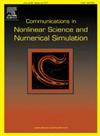Low-velocity impact response of rotating 2D-FGM annular plates with variable thickness
IF 3.8
2区 数学
Q1 MATHEMATICS, APPLIED
Communications in Nonlinear Science and Numerical Simulation
Pub Date : 2025-09-26
DOI:10.1016/j.cnsns.2025.109373
引用次数: 0
Abstract
In engineering applications, annular plates with non-uniform thickness profiles are widely used in various scenarios owing to their characteristics of reducing weight, optimizing material distribution, and maintaining sufficient stiffness and strength. However, the mechanical response of such structures is inherently more complex than that of uniformly thick plates due to the variation in geometric shape. Meanwhile, this complexity is further compounded by the unclear mechanisms governing how bidirectional functionally graded materials (2D-FGMs) and local geometric imperfections affect low-velocity impact responses in rotating variable-thickness annular plates. The present study investigates these nonlinear impact characteristics through a novel analytical framework. By synergistically combining the first-order shear deformation theory (FSDT) with the improved nonlinear Hertz contact theory, the nonlinear governing equations of the plate are derived. The degradation model is validated to ensure the correctness of the proposed model. Finally, numerical analysis is conducted using the Runge-Kutta method to investigate the effects of different parameters, such as material gradient index, thickness coefficient, impact location, and local imperfections, on the nonlinear low-velocity impact response characteristics of the annular plates.
变厚度旋转2D-FGM环形板的低速冲击响应
在工程应用中,非均匀厚度的环形板具有减轻重量、优化材料分布、保持足够的刚度和强度等特点,被广泛应用于各种场景。然而,由于几何形状的变化,这种结构的力学响应本质上比均匀厚板的力学响应更复杂。同时,双向功能梯度材料(2d - fgm)和局部几何缺陷如何影响旋转变厚度环形板的低速冲击响应的机制尚不清楚,这进一步加剧了这种复杂性。本研究通过一个新的分析框架来研究这些非线性冲击特性。将一阶剪切变形理论(FSDT)与改进的非线性赫兹接触理论协同结合,导出了板的非线性控制方程。对退化模型进行了验证,以确保所提模型的正确性。最后,采用龙格-库塔方法进行数值分析,研究了材料梯度指数、厚度系数、冲击位置、局部缺陷等不同参数对环形板非线性低速冲击响应特性的影响。
本文章由计算机程序翻译,如有差异,请以英文原文为准。
求助全文
约1分钟内获得全文
求助全文
来源期刊

Communications in Nonlinear Science and Numerical Simulation
MATHEMATICS, APPLIED-MATHEMATICS, INTERDISCIPLINARY APPLICATIONS
CiteScore
6.80
自引率
7.70%
发文量
378
审稿时长
78 days
期刊介绍:
The journal publishes original research findings on experimental observation, mathematical modeling, theoretical analysis and numerical simulation, for more accurate description, better prediction or novel application, of nonlinear phenomena in science and engineering. It offers a venue for researchers to make rapid exchange of ideas and techniques in nonlinear science and complexity.
The submission of manuscripts with cross-disciplinary approaches in nonlinear science and complexity is particularly encouraged.
Topics of interest:
Nonlinear differential or delay equations, Lie group analysis and asymptotic methods, Discontinuous systems, Fractals, Fractional calculus and dynamics, Nonlinear effects in quantum mechanics, Nonlinear stochastic processes, Experimental nonlinear science, Time-series and signal analysis, Computational methods and simulations in nonlinear science and engineering, Control of dynamical systems, Synchronization, Lyapunov analysis, High-dimensional chaos and turbulence, Chaos in Hamiltonian systems, Integrable systems and solitons, Collective behavior in many-body systems, Biological physics and networks, Nonlinear mechanical systems, Complex systems and complexity.
No length limitation for contributions is set, but only concisely written manuscripts are published. Brief papers are published on the basis of Rapid Communications. Discussions of previously published papers are welcome.
 求助内容:
求助内容: 应助结果提醒方式:
应助结果提醒方式:


